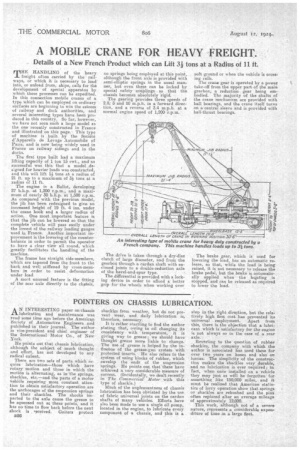POINTERS ON CHASSIS LUBRICATION.
Page 10

If you've noticed an error in this article please click here to report it so we can fix it.
AN INTERESTING paper on chassis lubrication and maintenance was read some time ago before the American Society of Automotive Engineers and published in their journal. The author is vice-president and chief engineer of the International Motor Co., of New York.
He points out that. chassis lubrication, although the subject of much thought and effort, has not developed to any radical extent.
There are two sets of parts which require lubrication—those which have rotary motion and those in -which the motion is alternating, as in-"the springs, shackles, etc.—and the parts of a motor vehicle requiring most constant attention to obtain satisfactory operation are the anchorages of the suspension springs and their shackles. The shocks imparted to the axle cause the grease to be squeezed out at these points, and it has no time to flow back before the next shock is iaaceived. Gaiters protect
B26 shackles from weather, but do not prevent wear, and daily lubrication is, therefore, necessary. It is rather startling to find the author stating that, owing to oil changing its consistency with temperature, it is giving way to grease; we should have thought grease more liable to change. The use of grease is helped by the influence of the grease-gun system with protected inserts. He also refers to the system of using blocks of rubber, which envelop the ends of the suspension springs. He points out that these have achieved a very considerable measure of success. (Incidentally, we dealt recently in The Commercial Motor with this type of shackle.) Much of the unpleasantness of chassis lubrication has been obviated by the use of fabric universal joints on the cardan shafts of many vehicles. Efforts have also been made to use a single oil pump, located in the engine, to lubricate every component of a chassis, and this is a step in the right direction, but the relatively high first cost has prevented its universal employment. .Apart from this, there is the abjection that .a lubricant which is satisfactory for the engine is not always so in the case of a rear axle.
Reverting to the question of rubber shackles, the company with which the author is associated has used these for over two years on buses and also on lorries. The simplicity of the construction makes the shackles very durable, and no lubrication is ever -required; in fact, when once installed on a vehicle they may just as well be forgotten for somethin,g like 150,000 miles, and it must be realized that American statistics of lorry operation show that springs or shackles are rehashed and the pins often replaced after an average mileage of approximately 12,000.
This work, although not of a severe nature, represents a considerable expenditure of time in a large fleet.
































